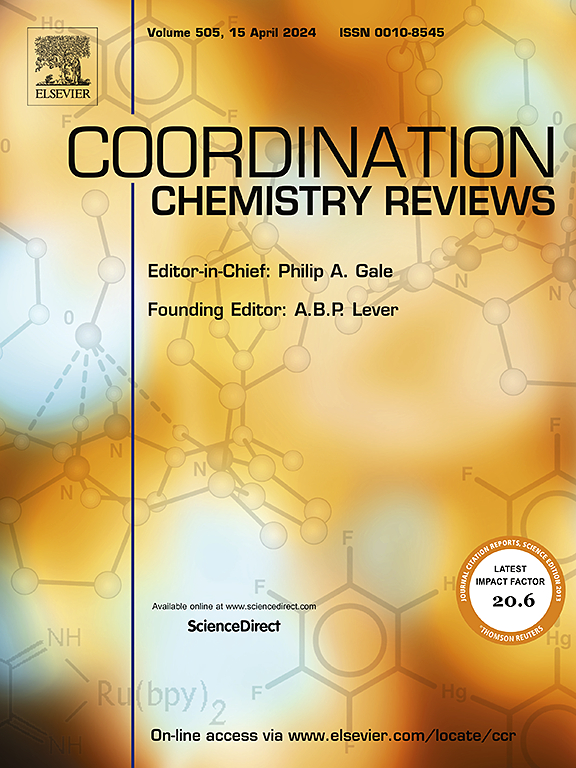Toward rational design of ionic liquid/Metal-Organic Framework composites for efficient gas separations: Combining molecular modeling, machine learning, and experiments to move beyond trial-and-error
IF 20.3
1区 化学
Q1 CHEMISTRY, INORGANIC & NUCLEAR
引用次数: 0
Abstract
This review presents a comprehensive overview of the emerging field of ionic liquid/metal-organic framework (IL/MOF) composites, which synergistically combine the unique properties of two material families, ILs and MOFs, for adsorption- and membrane-based gas separation applications. ILs, with their low volatility and tunable chemical properties, enhance the functionality of MOFs, which are highly porous materials characterized by their large surface areas and adjustable pore sizes. The effective integration of these two materials through various synthesis techniques has led to the development of novel IL/MOF composites exhibiting superior gas adsorption and separation capabilities, particularly for CO2 capture, compared to pristine MOFs. The use of these composites as fillers in polymers resulted in mixed matrix membranes with enhanced selectivities. This field is advancing rapidly, yet the design of IL/MOF composites still relies on a trial-and-error approach. After providing an overview of the current state-of-the-art in gas separation applications of IL/MOF composites, we specifically focused on the pivotal role of computational studies in both complementing and, beyond that, guiding the experimental design of novel IL/MOF composites. The importance of harnessing experiments, computational modeling, and machine learning methods to accelerate the discovery of new IL/MOF composites as adsorbents and membranes was discussed with recent examples. Finally, we addressed the current challenges and future opportunities in this rapidly evolving field, emphasizing the significant potential of IL/MOF composites to revolutionize the current gas adsorption and separation technologies.
离子液体/金属-有机框架复合材料的合理设计:结合分子建模、机器学习和实验,超越试错
本文综述了离子液体/金属有机框架(IL/MOF)复合材料的新兴领域,该领域协同结合了离子液体和金属有机框架两个材料家族的独特性能,用于吸附和膜基气体分离应用。离子液体具有低挥发性和可调的化学性质,增强了MOF的功能,MOF是一种高度多孔的材料,其特征是表面积大,孔径可调。通过各种合成技术有效整合这两种材料,开发了新型IL/MOF复合材料,与原始MOF相比,该复合材料具有优异的气体吸附和分离能力,特别是在二氧化碳捕获方面。将这些复合材料用作聚合物中的填料导致混合基质膜具有增强的选择性。该领域正在迅速发展,但IL/MOF复合材料的设计仍然依赖于试错法。在概述了IL/MOF复合材料气体分离应用的当前最新进展后,我们特别关注了计算研究在补充和指导新型IL/MFO复合材料实验设计方面的关键作用。通过最近的例子讨论了利用实验、计算建模和机器学习方法加速发现新的IL/MOF复合材料作为吸附剂和膜的重要性。最后,我们讨论了这一快速发展领域的当前挑战和未来机遇,强调了IL/MOF复合材料在彻底改变当前气体吸附和分离技术方面的巨大潜力。
本文章由计算机程序翻译,如有差异,请以英文原文为准。
求助全文
约1分钟内获得全文
求助全文
来源期刊

Coordination Chemistry Reviews
化学-无机化学与核化学
CiteScore
34.30
自引率
5.30%
发文量
457
审稿时长
54 days
期刊介绍:
Coordination Chemistry Reviews offers rapid publication of review articles on current and significant topics in coordination chemistry, encompassing organometallic, supramolecular, theoretical, and bioinorganic chemistry. It also covers catalysis, materials chemistry, and metal-organic frameworks from a coordination chemistry perspective. Reviews summarize recent developments or discuss specific techniques, welcoming contributions from both established and emerging researchers.
The journal releases special issues on timely subjects, including those featuring contributions from specific regions or conferences. Occasional full-length book articles are also featured. Additionally, special volumes cover annual reviews of main group chemistry, transition metal group chemistry, and organometallic chemistry. These comprehensive reviews are vital resources for those engaged in coordination chemistry, further establishing Coordination Chemistry Reviews as a hub for insightful surveys in inorganic and physical inorganic chemistry.
 求助内容:
求助内容: 应助结果提醒方式:
应助结果提醒方式:


